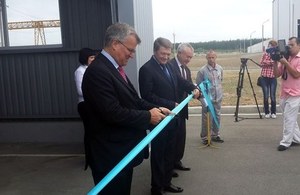Britain helps build a new storage for spent radioactive materials in Ukraine
With UK and EU support, a new storage facility opens to provide for 50 years of safe storage of 500,000 radiation sources from all over Ukraine

(Left to right) Simon Smith, British Ambassador; Yuriy Antipov, head of SAMEZ; Valentyn Melnychenko, head of “Radon”
The new storage facility for spent radioactive sources, located within the Chernobyl Exclusion Zone, will directly contribute to the safe and secure handling and storage of spent radioactive sources, accumulated in Ukraine.
Some 300,000 radioactive sources, previously used in medicine, construction and other industries in Ukraine, are to be safely stored in accordance with international radiation and physical safety and security standards.
The project, costing just over £11.3m, is funded by the UK Department of Energy and Climate Change and complemented by a €2m grant from the European Union. It forms part of a wider programme which supports the Global Partnership against the spread of weapons and materials of mass destruction.
Work began on the design stage of the storage facility in 2008 with construction commencing in 2011. It was completed and approved in early 2015. The opening of the facility marks its formal handover to the Ukrainian State Agency for Management of the Exclusion Zone (SAMEZ).
SAMEZ will now ensure that it is fully utilised, transferring spent radioactive sources from existing storage locations across Ukraine to the new facility.
The facility is designed for the acceptance, conditioning and safe storage of alpha, beta, gamma and neutron radiation sources that are currently kept in the storages of enterprises of the state Corporation “Radon” in Kyiv, Lviv, Kharkiv, Donetsk, Dnipropetrovs’k and Odesa.
It is equipped with a radiation protection glove box for handling the alpha sources and three “hot cells” for the safe handling of the highly radioactive sources. The facility has up-to-date machinery and radiation control systems that will minimize the probability of accidents.
The storage zone will provide for 50 years of safe storage of approximately 500,000 sources of different types, with an overall estimated radiation activity level of 1 million Ci.
Speaking at the handover ceremony, Simon Smith, the British Ambassador to Ukraine, said:
The opening of the new storage facility in Chernobyl exclusion zone will bring significant benefits in terms of long-term storage of spent radioactive materials. Besides that, it will help to reduce the threat of illegal trafficking of radioactive substances, the risks of them falling into the hands of terrorists, as well as the risks related to the impact on the environment.
The UK attaches a great importance to the work with the international community in order to improve the effectiveness of management and transportation of radiological sources in Ukraine.
Further information
-
The UK Global Threat Reduction Programme (GTRP) supports the G8 Global Partnership (GP) against the spread of weapons and material of mass destruction, which was launched at the G8 Summit in Kananaskis, Canada, in 2002. Its purpose is to reduce the risk that chemical, biological, radiological or nuclear materials and related equipment, technology and expertise will be misused.
-
The GTRP is jointly overseen and implemented by three UK government bodies. The Foreign and Commonwealth Office (FCO) provides the policy lead; the Ministry of Defence (MoD) is responsible for work on assistance with chemical weapon destruction and biological engagement and non-proliferation. The Department of Energy and Climate Change (DECC) is responsible for the radiological and nuclear programme, under which the UK is contributing to the eventual safe and secure handling and storage of spent radioactive sources in Ukraine.